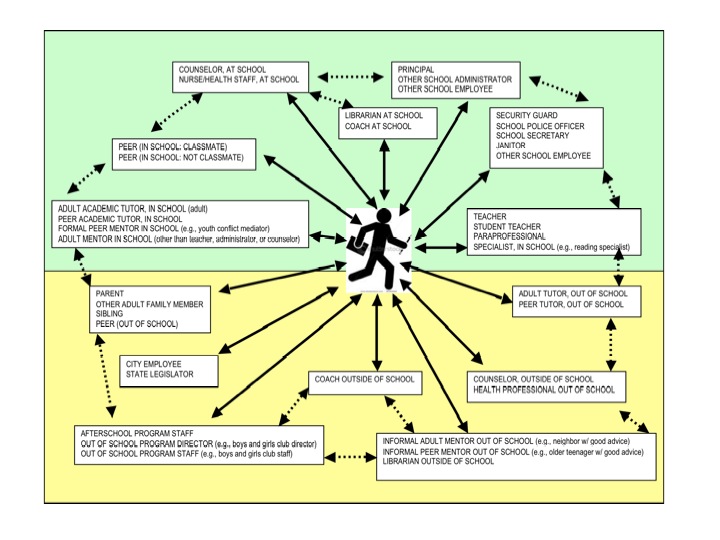Research base
From Oneville Wiki
Research Base: Why should we improve the communication infrastructure of public education?
Lots of research shows that if people have a "high expectations, high help" frame of mind about doing what it takes to support young people's full potential (Ferguson 2008), students do better when the key people in their lives communicate about how they are doing and what they can do -- and about the resources available to help.
To partner in young people’s success, people need tools and strategies helping them to communicate about the individual children they share (What does Jose love to learn? How is he doing on credits toward graduation?); about the classrooms they share (what’s the homework? Who has an idea on the assignment?), about the schools they share (what afterschool opportunities are available for children? What actions would improve the school?), and about the city they share (where’s the free science fair? How might we improve education here?).
Finally, supporting young people requires a combination of face to face communications (like a parent-teacher meeting, an afterschool discussion between student and teacher, or a parent coffee hour where people share information and build relationships), print communications (like a handout in a backpack, a sign on the wall informing a parent of an opportunity, or a copy of student work at a parent-teacher conference), and electronic communications (like a student checking her grades online or a parent posting a local resource on a school listserv).
But the communication infrastructure of partnership in public education is pretty underdeveloped, in an era when commonplace and free technology could make communication and information-sharing in education easier than ever.
Examples: across the country, principals serving low-income children remain unable to quickly view and sort basic information on children, because they can’t afford the software to do it. Reliant on face to face meetings that are hard to schedule, overloaded teachers and afterschool providers rarely communicate about what students need to work on. Due to translation and tech-skills barriers, many immigrant parents remain unaware of educational opportunities available in their schools or community. Teachers and afterschool providers, or parents and teachers, or teachers and students, often rarely exchange information on how students are doing personally or what they love to learn – even as youth communicate constantly about both via tech outside of school.
Wealthy districts are investing in expensive technology for information-sharing between partners. We've wanted to test the potential of free and commonplace technology and low-cost communication strategies for supporting diverse partners in young people’s lives to collaborate. And, we've wanted to do this in collaboration with diverse educators, youth, families, and technologists.
So, we’ve been working to test -- and then, as necessary, create -- free, open-source, and low-cost tools and strategies for linking diverse partners in desired communications across lines of income, racial/ethnic background, language difference and tech literacy. Our goal has become to hone, over time and in collaboration with folks elsewhere, a toolkit of such tools and strategies enabling diverse supporters to collaborate in student success.
So far, we’ve built new tools only when we found no free tool available to test (our dashboards and hotline). We've also been testing existing free tools, to see how they can help link diverse partners. We’ve tested Google Voice in our texting pilot (and modified it to afford one-to-many texting). We’ve tested Google Translate, Googledocs, Google spreadsheets, and Gmail in our schoolwide toolkit. We’ve tested Googlesites in our ePortfolio pilot, as well as Wikispaces, and we’ve used Wordpress to blog out and Mediawiki to organize our ideas for this website!
While testing technologies, we are also figuring out ways to tap local people power more efficiently. For example, bilingual parents have been figuring out how they, as volunteers, might be willing to make monthly calls to other immigrant parents as “Connectors” or translate key info from a Googleform onto a hotline.
We've also been training more people to use the technology around them (the ePortfolio project is a great example) and, making the case for better and more available hardware and internet access in public schools too.
You might call all this "improving the communication infrastructure of public education." Our goal now is to connect with people doing similar work in other places.
